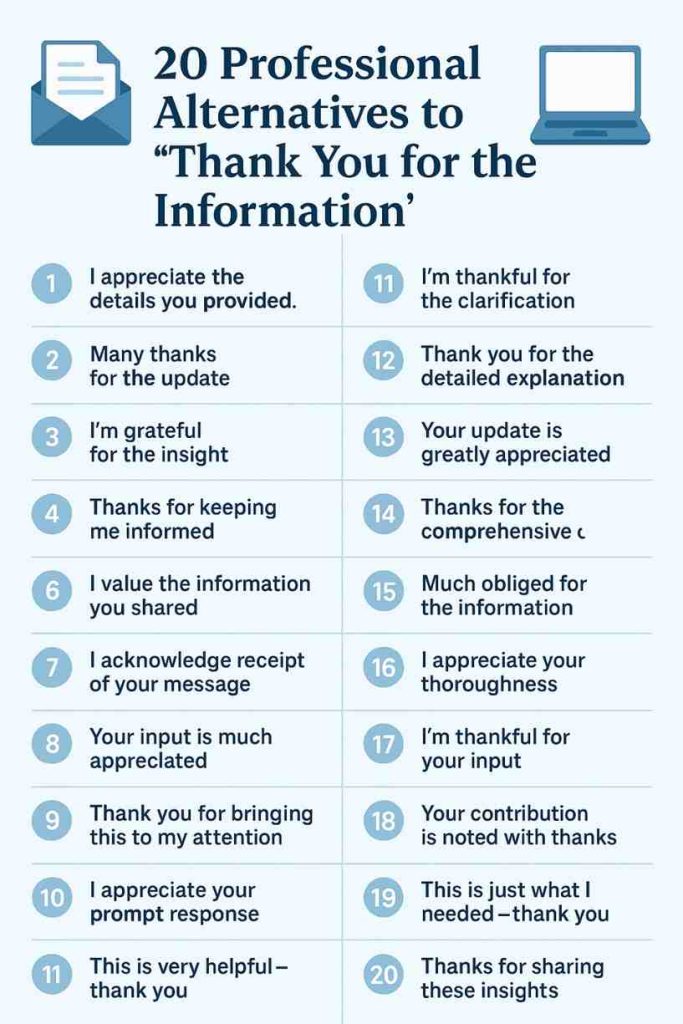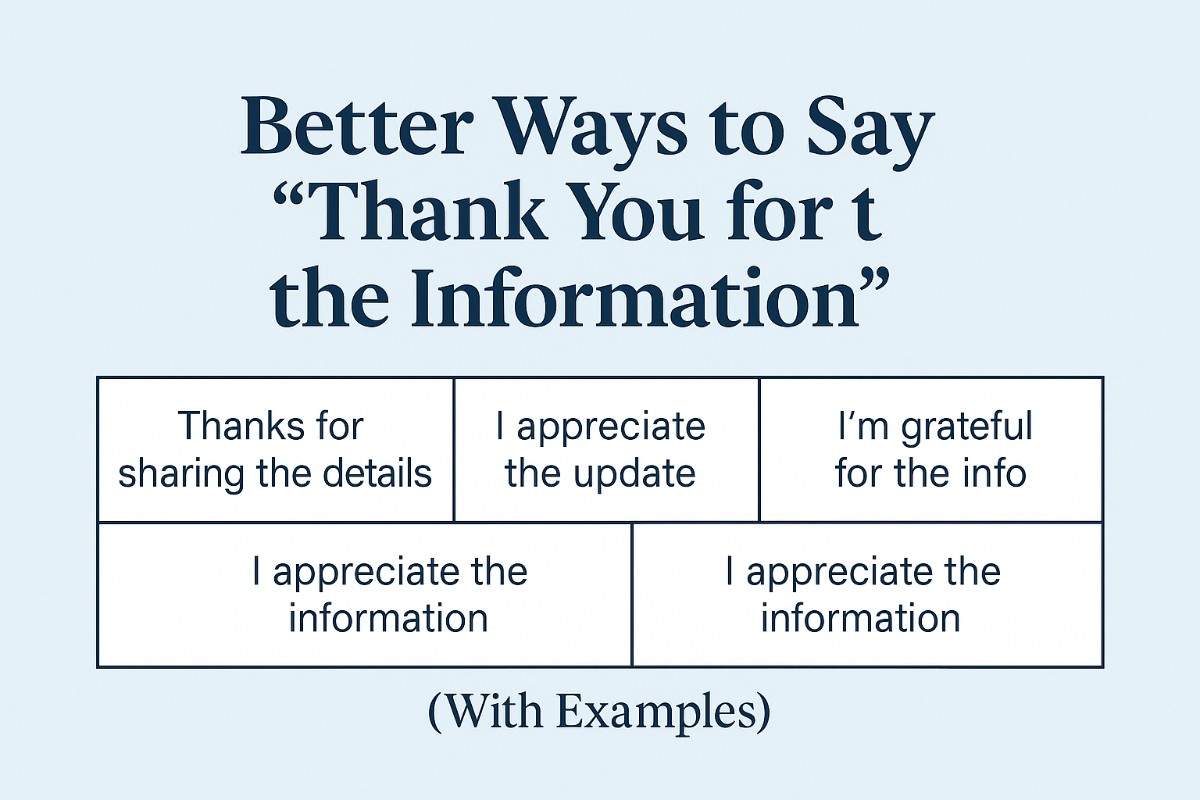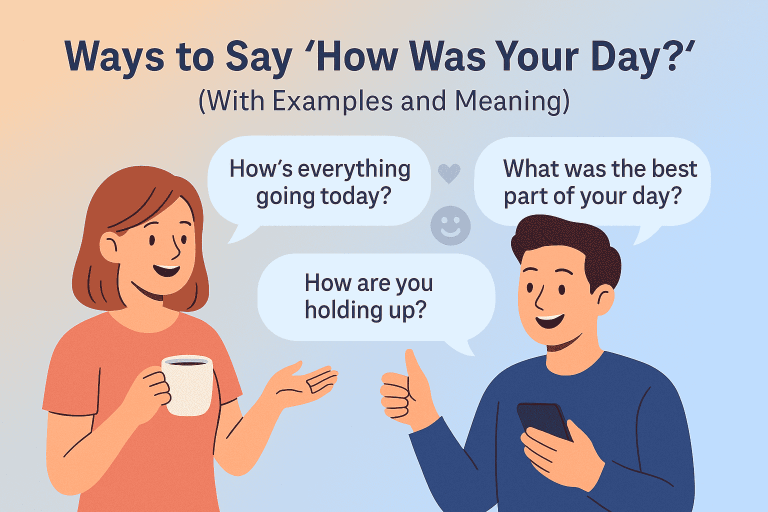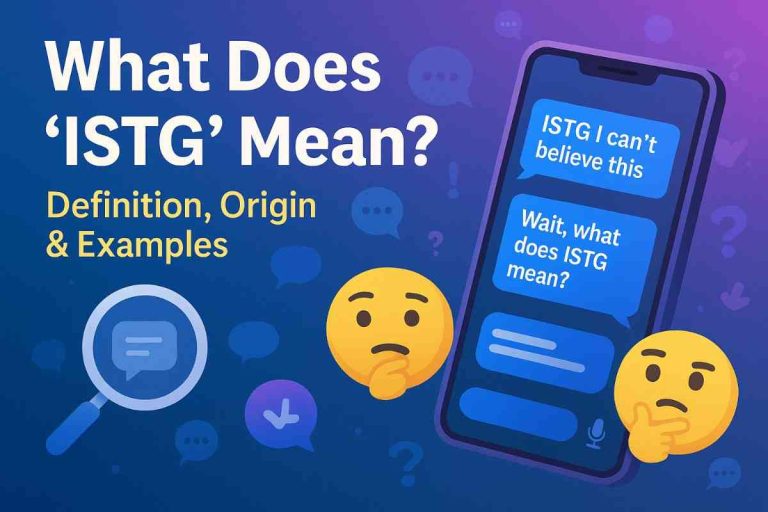Better Ways to Say “Thank You for the Information” (With Examples)
In professional settings, you often need to respond politely when someone shares useful details. One common phrase? “Thank you for the information.” It works. It’s polite. But it’s also used a lot — maybe too much.
If you’re sending emails or messages often, it helps to have fresh ways to express gratitude. Not only does it keep your tone friendly, but it also shows thoughtfulness.
This guide breaks down what the phrase means, when to use it, and offers better alternatives. Whether you’re writing to a client, coworker, or manager, you’ll find a way to say thanks that fits the moment.
What Does “Thank You for the Information” Mean?
The phrase is simple. It tells someone you appreciate the details they shared with you.
It could be facts, a report, instructions, or even a short update. Saying “thank you for the information” shows good manners and helps keep communication smooth and respectful.
When and Where to Use “Thank You for the Information”
This phrase fits many settings — especially in work-related emails or messages. Here are a few common situations:
- After receiving project updates
- When someone shares research or data
- If a colleague helps explain a process
- After being briefed on a task
- When you ask a question and get a helpful answer
It’s especially useful in formal or semi-formal emails. For example:
“Thank you for the information you sent over about the new system.”
But while it’s useful, using the same phrase every time can make your writing feel robotic or lazy.
That’s where alternatives come in.

20 Professional Alternatives to “Thank You for the Information”
Let’s be honest — variety matters. Below are 20 other ways to say “thank you for the information,” especially when you want to sound polished, kind, or just a little different.
1. I appreciate the update.
Meaning: You’re thankful for a recent piece of news or progress.
Explanation: Use this for brief or important updates.
Example: “I appreciate the update on the delivery status.”
Best Use: Project check-ins or follow-up messages.
2. Thanks for keeping me informed.
Meaning: You’re glad someone is keeping you in the loop.
Explanation: Use this when someone shares ongoing updates.
Example: “Thanks for keeping me informed during the rollout.”
Best Use: Team communications or project updates.
3. That’s helpful, thank you.
Meaning: The information helped you in some way.
Explanation: It’s both polite and personal.
Example: “That’s helpful, thank you! I’ll review it right away.”
Best Use: Responses to answers, guidance, or tips.
4. Thanks for letting me know.
Meaning: You’re showing gratitude for being told something.
Explanation: Works well for informal or quick notes.
Example: “Thanks for letting me know about the change in schedule.”
Best Use: Slack messages, texts, or casual emails.
5. I’m grateful for the details.
Meaning: You appreciate the specific information given.
Explanation: It’s polite and a bit more formal.
Example: “I’m grateful for the details in your report.”
Best Use: Business emails or formal replies.
6. Thanks for clarifying that.
Meaning: You’re thankful someone made something clearer.
Explanation: Use it when someone clears up confusion.
Example: “Thanks for clarifying that section of the contract.”
Best Use: Legal, financial, or technical conversations.
7. Thank you for bringing this to my attention.
Meaning: You’re glad someone pointed something out.
Explanation: Works well for issues or concerns.
Example: “Thank you for bringing this to my attention — I’ll look into it.”
Best Use: When someone reports errors or risks.
8. Appreciate the insight.
Meaning: You value the shared opinion or idea.
Explanation: This shows you respect their knowledge.
Example: “Appreciate the insight on how to handle the client.”
Best Use: When receiving advice or analysis.
9. Thank you for the heads-up.
Meaning: You’re thankful for early or advance notice.
Explanation: More casual and common in teamwork.
Example: “Thank you for the heads-up about tomorrow’s meeting.”
Best Use: Reminders or quick alerts.
10. Thanks for sending this over.
Meaning: You’re showing gratitude for a shared file or link.
Explanation: Best when receiving a document or asset.
Example: “Thanks for sending this over — it’s exactly what I needed.”
Best Use: Emails with attachments or resources.
11. Much appreciated.
Meaning: A brief and polite way to say thanks.
Explanation: Simple, fast, and respectful.
Example: “Much appreciated — that helps a lot.”
Best Use: Casual but respectful emails.
12. Appreciate the follow-up.
Meaning: You’re thankful for someone checking in or circling back.
Explanation: Great for keeping momentum.
Example: “Appreciate the follow-up — I’ll respond soon.”
Best Use: Sales, support, or service-based work.
13. Thanks for looping me in.
Meaning: You’re glad to be included in a conversation or thread.
Explanation: Common in email chains or group chats.
Example: “Thanks for looping me in — I’ll take it from here.”
Best Use: Internal communications or collaborations.
14. Appreciate the quick response.
Meaning: You value the speed of the reply.
Explanation: Shows you noticed the fast reply.
Example: “Appreciate the quick response — that’s very helpful.”
Best Use: Customer service, urgent topics.
15. Thank you for the background.
Meaning: You’re grateful for context or history.
Explanation: Good when catching up on an issue.
Example: “Thank you for the background — I understand now.”
Best Use: Long-term projects or team handovers.
16. Thanks for pointing that out.
Meaning: You’re thankful for someone spotting an issue or idea.
Explanation: Works for feedback or bug reports.
Example: “Thanks for pointing that out — I’ll fix it.”
Best Use: Tech, QA, editing, or internal reviews.
17. Thank you for sharing.
Meaning: You appreciate what was shared, even informally.
Explanation: Broad and useful for many settings.
Example: “Thank you for sharing this article — it was timely.”
Best Use: Professional content or helpful links.
18. I appreciate your input.
Meaning: You value someone’s ideas or comments.
Explanation: Respectful and professional.
Example: “I appreciate your input during the meeting.”
Best Use: Group decisions or brainstorming.
19. Thanks for the clarification.
Meaning: You’re glad someone cleared up confusion.
Explanation: Useful in back-and-forth emails.
Example: “Thanks for the clarification on that figure.”
Best Use: Reports, financials, or feedback loops.
20. Thank you for the explanation.
Meaning: You’re grateful someone explained a topic or issue.
Explanation: Works for long replies or deep answers.
Example: “Thank you for the explanation — now it makes sense.”
Best Use: Support tickets, coaching, or feedback.
Also Read – 19 Better Ways to Say “Welcome Back Home”
Simple and Polite Responses to “Thank You for the Information”
When someone thanks you for the information, how should you reply? You don’t always need to say “you’re welcome.” Here are a few smoother options:
- “Glad I could help.”
- “No problem at all.”
- “Anytime!”
- “Of course — happy to assist.”
- “Let me know if you need anything else.”
- “Always here if you need more info.”
- “Thanks for following up.”
Keep it friendly and warm. If it’s a formal reply, you might say:
- “You’re very welcome. Please don’t hesitate to reach out again.”
- “I’m happy to help. Let me know if you need further assistance.”
Conclusion
Saying “thank you for the information” is a great way to keep conversations polite and professional. But it doesn’t have to be your only option. Whether you’re replying to a team member, client, or vendor, using varied phrases helps you sound more natural, more human.
It also shows that you’re engaged — not just going through the motions.
So next time someone shares an update or sends over a file, pick a phrase that fits the tone, the moment, and the relationship. Because how you say “thanks” matters more than you think.







